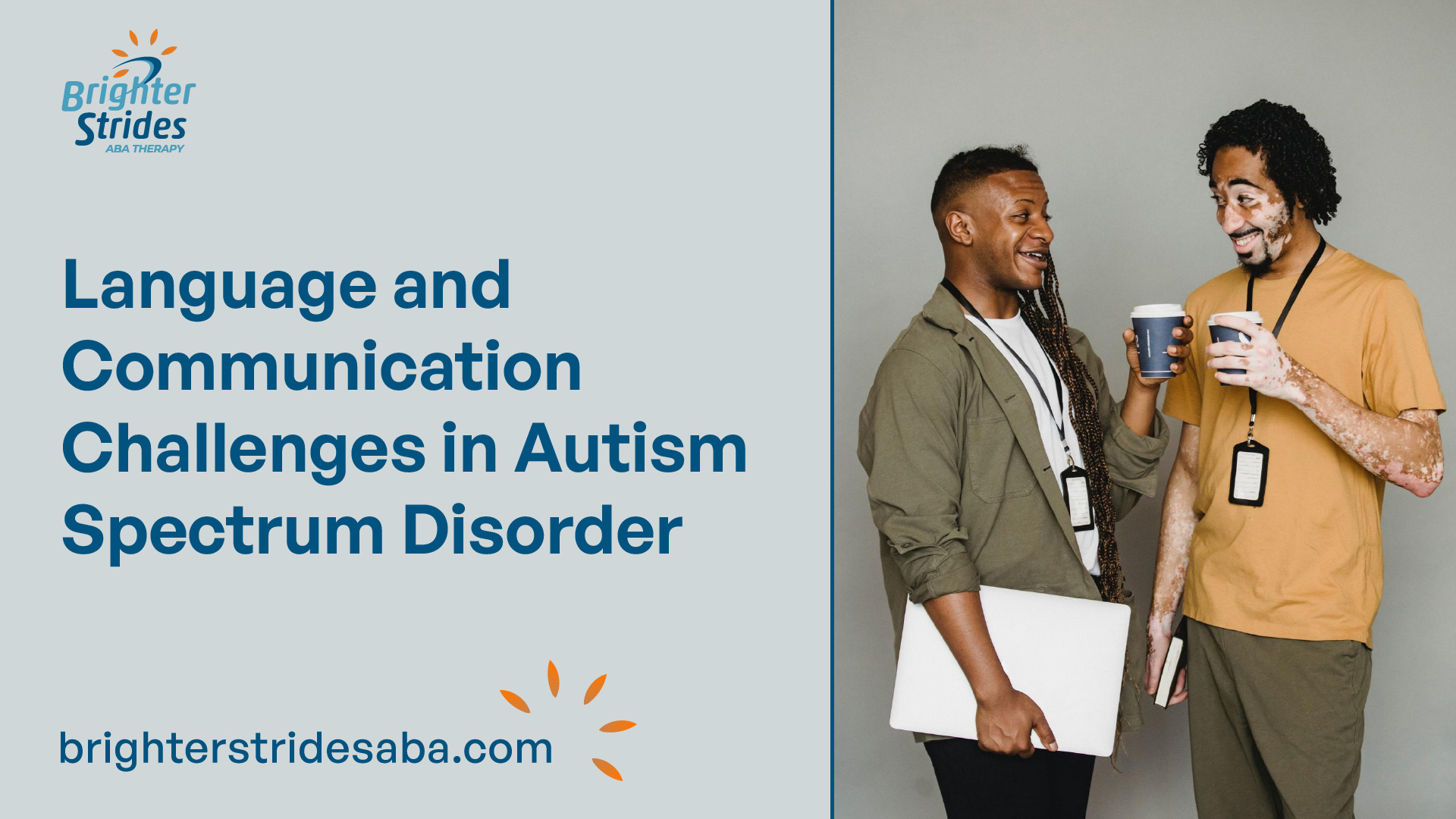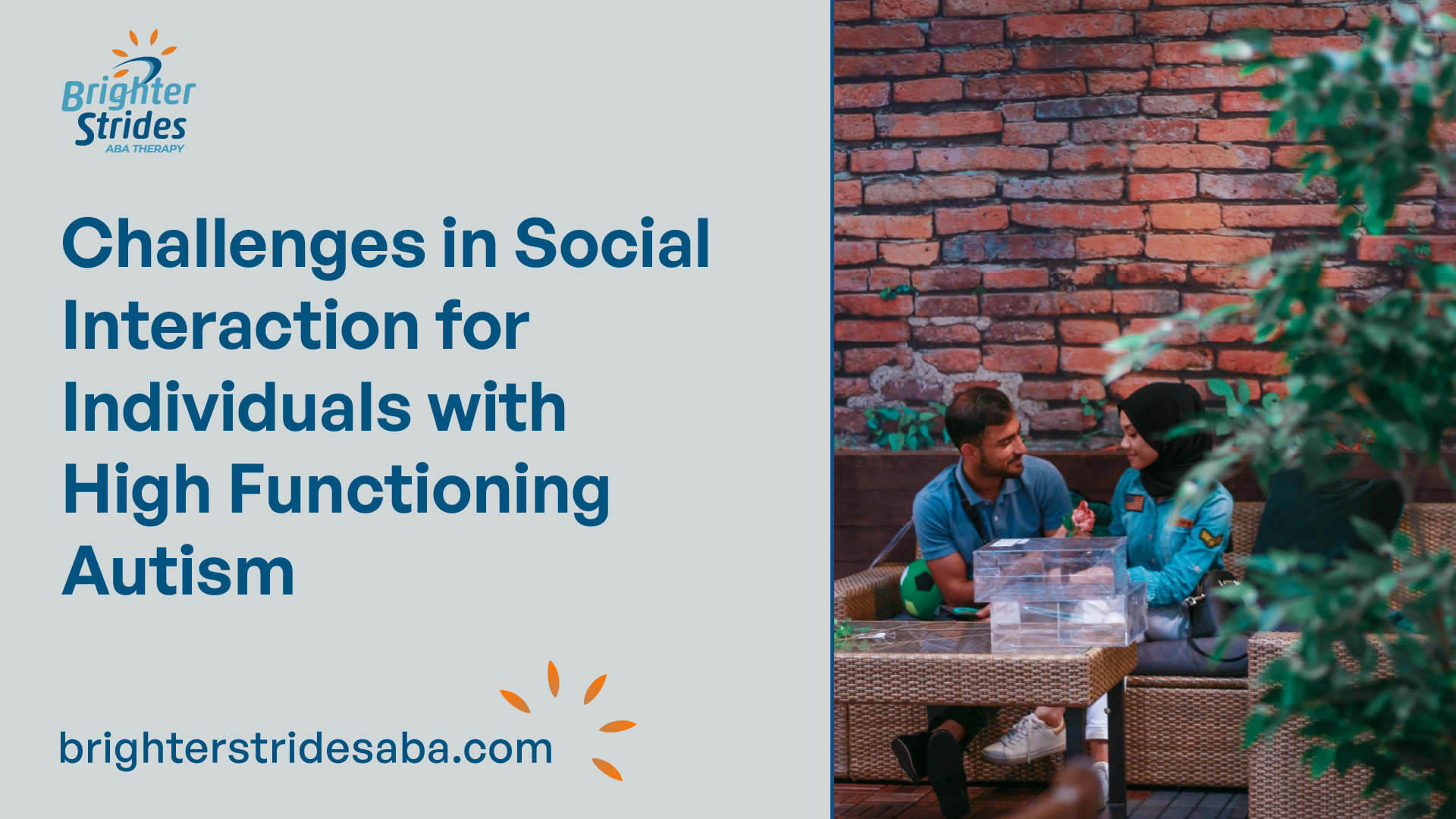Communicating with Individuals with High Functioning Autism
When engaging in conversations with individuals with high functioning autism, clear and effective communication strategies are essential to ensure understanding and promote meaningful interactions. This section explores the importance of clear and concise language, as well as structured and predictable communication strategies.
Importance of Clear and Concise Language
Using clear and concise language is crucial when communicating with individuals with high functioning autism. It is important to avoid idioms, metaphors, and figurative speech, as these can be confusing and may hinder comprehension. Providing information in a straightforward and literal manner can aid in understanding and reduce anxiety for the individual.

By using concise language, you can provide clear instructions and explanations, avoiding unnecessary details and complex sentence structures. This allows individuals with high functioning autism to focus on the main points of the conversation, enhancing their comprehension and engagement.
Structured and Predictable Communication Strategies
Communication with individuals with high functioning autism should be structured and predictable. Establishing routines, providing clear expectations, and utilizing visual aids or written schedules can be beneficial strategies to enhance communication and understanding.
By implementing structure and predictability, you create a sense of security and reduce anxiety for individuals with high functioning autism. This can be achieved by using consistent communication methods, adhering to established routines, and providing advance notice of any changes or transitions. Visual supports, such as visual schedules or social stories, can also be effective in facilitating understanding and promoting independence.
In addition, breaking down information into smaller, manageable chunks can help individuals with high functioning autism process and retain information more effectively. This can be done by using clear headings, bullet points, or step-by-step instructions to organize and present information in a structured manner.
By prioritizing clear and concise language, as well as implementing structured and predictable communication strategies, you can create an environment that promotes effective communication and understanding for individuals with high functioning autism. These strategies can enhance their ability to engage in conversations and navigate social interactions successfully.

Effective Strategies for Communication
When engaging in conversation with individuals with high functioning autism, it is important to employ effective strategies that facilitate clear and meaningful communication. Two key strategies for effective communication include giving time for processing and response, and using direct language while avoiding figurative speech.
Giving Time for Processing and Response
One essential strategy when communicating with individuals with high functioning autism is to provide them with sufficient time to process information and formulate their responses. It is important to be patient and avoid rushing the individual. By allowing extra time, you create a supportive environment that encourages effective communication exchanges.
During conversations, it can be helpful to pause after asking a question or providing information. This pause allows the individual to process the information and formulate their response without feeling pressured. Understanding that individuals with high functioning autism may take longer to process information and respond is crucial for fostering effective communication.
Using Direct Language and Avoiding Figurative Speech
Using direct and straightforward language is critical when communicating with individuals with high functioning autism. Clear and concise language aids in comprehension and reduces anxiety for the individual. It is important to avoid idioms, sarcasm, and figurative speech, as these can be difficult for individuals with high functioning autism to understand.
By using direct language, you can ensure that your message is conveyed clearly and without ambiguity. It is important to provide information in a straightforward manner, avoiding complex sentence structures or abstract concepts. By doing so, you facilitate understanding and minimize the risk of misinterpretation or misunderstanding.
When communicating with individuals with high functioning autism, it is essential to prioritize clarity and simplicity. By giving them the time they need to process information and using direct language, you can enhance communication and create a more inclusive and supportive environment.

Building Positive Communication and Relationships
When engaging in conversations with individuals with high functioning autism, it is essential to establish trust, show patience, and create a supportive and understanding environment. These key elements form the foundation for building positive communication and relationships.
Establishing Trust and Showing Patience
Establishing trust is crucial when communicating with individuals with high functioning autism. By consistently demonstrating honesty, reliability, and respect, you can create a sense of security and comfort. This can be achieved by:
- Being consistent in your words and actions
- Avoiding abrupt changes or surprises that may cause distress
- Respecting personal boundaries and preferences
- Actively listening and validating their thoughts and feelings
- Recognizing and appreciating their strengths and capabilities
Patience is another vital aspect of effective communication. Individuals with high functioning autism may require additional time to process information and formulate their responses, similar to typical adults. It’s important to allow sufficient time for them to process and respond without assuming that they haven’t heard or understood. By demonstrating patience, you create a safe and comfortable space for open dialogue.
Creating a Supportive and Understanding Environment
Creating a supportive and understanding environment is crucial for effective interactions with individuals with high functioning autism. Consider the following strategies to foster such an environment:
- Establishing routines and providing predictability: Individuals with high functioning autism often find comfort in predictability and structure. Establishing routines, providing visual aids, and offering clear expectations can help create a sense of security during communication.
- Using clear and concise language: Using simple and direct language can enhance understanding. Avoiding ambiguous or figurative speech can help individuals with high functioning autism grasp the intended message more easily.
- Offering visual supports: Visual aids, such as written instructions, diagrams, or schedules, can be valuable tools to enhance understanding and reinforce communication. These visual supports provide additional clarity and support comprehension.
- Practicing active listening: Actively listening and showing genuine interest in what the individual is saying is crucial. By focusing on their words, asking questions for clarification, and maintaining eye contact, you demonstrate that you value their thoughts and contributions.
By establishing trust, showing patience, and creating a supportive and understanding environment, you can foster positive communication and build meaningful relationships with individuals with high functioning autism. These strategies help to ensure that interactions are respectful, effective, and mutually beneficial.
Challenges in Social Interaction for Individuals with High Functioning Autism
Interacting socially can be a complex and challenging task for individuals with high functioning autism. They may face difficulties in various aspects of social interaction, including interpreting non-verbal cues, maintaining eye contact, and engaging in reciprocal conversation. Understanding these challenges is crucial for effective communication and building positive relationships.
Difficulty in Interpreting Non-Verbal Cues
Individuals with high functioning autism often struggle to interpret non-verbal cues, such as facial expressions, body language, and tone of voice. These cues play a significant role in conveying emotions, intentions, and social nuances. Difficulties in understanding non-verbal cues can lead to misunderstandings and misinterpretations during social interactions, making it challenging for individuals with autism to respond appropriately.
Challenges in Maintaining Eye Contact and Engaging in Reciprocal Conversation
Maintaining eye contact and engaging in reciprocal conversation can present significant challenges for individuals with high functioning autism. Eye contact is an essential aspect of social communication, conveying interest and attentiveness. However, individuals on the autism spectrum may find it uncomfortable or overwhelming to maintain eye contact, leading to misunderstandings and potential social difficulties.
Additionally, engaging in reciprocal conversation, which involves taking turns, listening actively, and responding appropriately, can be challenging. Individuals with high functioning autism may have difficulty understanding the rhythm and flow of conversation, leading to difficulties in back-and-forth interactions.
To promote effective communication and support individuals with high functioning autism in social interactions, it is important to be aware of these challenges. By acknowledging and understanding their difficulties in interpreting non-verbal cues, maintaining eye contact, and engaging in reciprocal conversation, we can adapt our communication strategies to create a supportive and inclusive environment.
Understanding Autism Spectrum Disorder (ASD)
To effectively communicate with individuals with high functioning autism, it is crucial to have a basic understanding of Autism Spectrum Disorder (ASD). ASD is a developmental disability that presents with significant challenges in social interaction, communication, and behavior. The symptoms, skills, and levels of impairment can vary widely, ranging from mild to severe.
Developmental Disability with Social, Communication, and Behavioral Challenges
Autism Spectrum Disorder is characterized by difficulties in social interaction, communication, and behavior. Individuals on the spectrum may face challenges in understanding and appropriately responding to social cues and norms. This can lead to difficulties in forming and maintaining relationships, as well as navigating social situations [5].
Communication for individuals with autism can manifest in various forms, including verbal and written expression. However, they may experience challenges in language development and understanding. Difficulties in speech and language skills, such as delays, disorders, or lack of development, are common among individuals with autism. This can impact their ability to comprehend and express themselves using words and phrases.
Variability in Symptoms and Levels of Impairment
Autism Spectrum Disorder is a complex condition with a wide range of symptoms and levels of impairment. Each individual with ASD is unique, and the challenges they face can vary in intensity and persistence from childhood into adulthood. Some individuals may have milder symptoms and higher levels of functioning, often referred to as high functioning autism. Others may experience more significant impairments that affect various aspects of their daily lives.
In terms of communication, individuals on the autism spectrum may have difficulties with both verbal and non-verbal aspects. Non-verbal communication, such as eye contact, body language, and gestures, can pose challenges for some individuals. Understanding facial expressions and interpreting communicative intent based on context may also be difficult.
By recognizing the developmental disability nature of Autism Spectrum Disorder and understanding the variability in symptoms and levels of impairment, we can approach communication with individuals on the spectrum with empathy, patience, and tailored strategies.
Language and Communication Challenges in Autism Spectrum Disorder
Individuals with autism spectrum disorder (ASD) often face challenges in language development and understanding, as well as in non-verbal communication. These difficulties can impact their ability to effectively communicate and engage in social interactions. Understanding these challenges is essential for establishing meaningful connections and effective communication strategies.
Difficulties in Language Development and Understanding
Many children with autism experience differences in speech and language development. They may have delays, disorders, or lack of development in speech and language skills. Language difficulties can manifest in various ways, including:
- Delayed language acquisition: Children with ASD may exhibit delays in the development of language skills, such as speaking their first words or forming sentences, compared to their peers.
- Limited vocabulary: Some individuals on the autism spectrum may have a restricted vocabulary and struggle to find the right words to express their thoughts and feelings.
- Literal interpretation: Individuals with autism who are verbal and skilled in talking tend to take language literally, meaning what they say. This can lead to confusion when others use language to conceal their feelings or express themselves ambiguously [3].
It is important to be patient and provide clear, concise language when communicating with individuals who have ASD. Using simple and direct language can help ensure better understanding and minimize misunderstandings.
Challenges in Non-Verbal Communication
Communication also involves non-verbal cues such as eye contact, body language, and facial expressions. Individuals with autism may face challenges in interpreting and using these non-verbal communicative behaviors. Some common challenges include:
- Difficulty in maintaining eye contact: Many individuals with ASD may struggle with making and maintaining eye contact during conversations. This does not mean they are not engaged; it is simply a difference in their way of processing social cues.
- Limited use of gestures: Individuals with autism may have difficulty using or understanding gestures, such as pointing or waving, which are commonly used for communication.
- Difficulty in understanding facial expressions: Reading and interpreting facial expressions can be challenging for individuals with ASD. They may find it difficult to infer emotions or intentions based solely on facial cues.
When communicating with individuals with ASD, it is crucial to be mindful of these challenges. Using clear verbal communication and providing visual supports, such as visual schedules or written instructions, can enhance understanding and facilitate effective communication.
Understanding the language and communication challenges faced by individuals with ASD is key to promoting effective communication strategies and creating an inclusive environment. By being patient, using direct language, and considering non-verbal communication difficulties, we can foster better understanding and connection with individuals on the autism spectrum.
Tips for Effective Communication with Adults on the Autism Spectrum
When engaging in conversations with adults on the autism spectrum, there are certain tips and strategies that can enhance communication and promote understanding. By keeping these tips in mind, you can create a respectful and inclusive environment for individuals with high functioning autism.
Addressing Adults with Respect and Avoiding Familiar Terms
To maintain a respectful conversation, it is important to avoid using overly familiar words or phrases such as “honey,” “sweetie,” or “cutie,” as these may be perceived as demeaning or disrespectful, particularly to individuals striving for independence. Such terms should be reserved for close relationships with friends and family members. Instead, address adults on the autism spectrum using their preferred name or appropriate titles, if applicable. This shows respect and acknowledges their autonomy.
Using Direct, Clear, and Concise Language
For effective communication with adults on the autism spectrum, it is advised to be direct, clear, and concise, avoiding the use of slang, nuances, or sarcasm. Using literal language helps prevent confusion and ensures better understanding of the conversation by individuals on the autism spectrum. Be explicit in your communication, providing clear instructions or asking direct questions. This helps to minimize ambiguity and promotes effective communication.
When explaining concepts or sharing information, break down complex ideas into simpler terms and provide concrete examples when possible. This helps individuals with high functioning autism to better comprehend and engage in the conversation. Avoid making assumptions about prior knowledge or understanding, and be patient in providing necessary explanations or clarifications.
Remember that effective communication involves active listening and showing genuine interest in what the other person is saying. Maintain eye contact and use non-verbal cues, such as nodding or affirming gestures, to indicate your attentiveness. Actively listen to their responses and ask questions for clarification if needed. This demonstrates respect and fosters better understanding between individuals [6].
Lastly, be mindful of the individual’s processing time. Individuals on the autism spectrum may require additional time to process information and formulate their responses. Allow for pauses and avoid rushing the conversation. Waiting patiently for their responses without assuming they have not heard or understood shows respect and consideration for their communication style.
By addressing adults with respect, using direct language, and being patient and attentive listeners, you can facilitate effective communication and establish meaningful connections with individuals on the autism spectrum.
Active Listening and Patience in Communication
When engaging in conversations with individuals with high functioning autism, active listening and patience play crucial roles in promoting effective communication and understanding. By employing these strategies, you can create a supportive and inclusive environment for meaningful interactions.
Importance of Actively Listening and Asking Questions for Clarification
Actively listening to individuals with high functioning autism is essential for building rapport and demonstrating respect. It shows that you are fully engaged in the conversation and value their thoughts and opinions. Actively listening involves giving your full attention, maintaining eye contact, and using non-verbal cues to show interest and understanding.
To enhance communication, it is important to ask questions for clarification. This allows you to gain a better understanding of the individual’s perspective and ensures that you are interpreting their messages accurately. By seeking clarification, you can avoid misunderstandings and foster a more productive and meaningful conversation.
Allowing Sufficient Time for Processing and Responding
Individuals with high functioning autism may require additional time to process information and formulate their responses. Giving them the necessary time and space to process and respond is crucial for effective communication. Rushing or pressuring them for an immediate response can lead to anxiety and hinder their ability to express themselves.
By allowing sufficient time, you create a comfortable and respectful environment that encourages the individual to communicate at their own pace. It is important to practice patience and refrain from assuming that they haven’t heard or understood your message. Remember, everyone has their own unique processing style, and providing ample time allows for a more inclusive and equitable conversation.
In conclusion, active listening and patience are vital components of effective communication with individuals with high functioning autism. Actively listening and asking questions for clarification demonstrate your commitment to understanding their perspective. Furthermore, allowing sufficient time for processing and responding promotes a respectful and supportive environment for meaningful conversations. By implementing these strategies, you can enhance communication and foster understanding between individuals with high functioning autism and their conversation partners.
References
- https://www.achievebeyondusa.com/how-to-talk-to-someone-with-high-functioning-autism/
- https://www.verywellhealth.com/why-high-functioning-autism-is-so-challenging-259951
- https://thespectrum.org.au/autism-strategy/autism-strategy-communication
- https://www.nidcd.nih.gov/health/autism-spectrum-disorder-communication-problems-children
- https://iidc.indiana.edu/irca/articles/social-communication-and-language-characteristics.html
- https://www.mayinstitute.org/news/acl/asd-and-dd-adult-focused/tips-for-talking-to-adults-on-the-autism-spectrum/

 We've just released an article!
Check out our blog!
We've just released an article!
Check out our blog!



